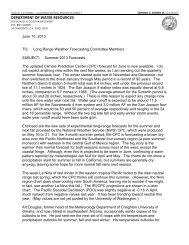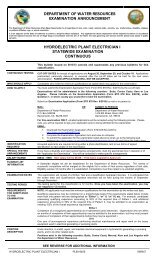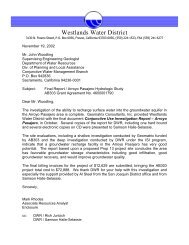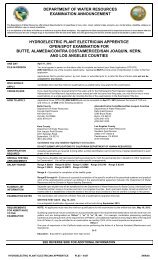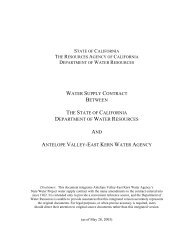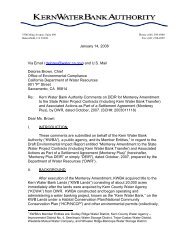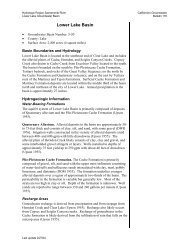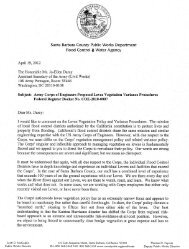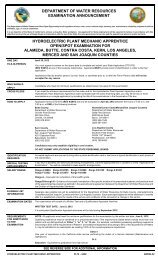Bulletin 1.pdf - California Department of Water Resources - State of ...
Bulletin 1.pdf - California Department of Water Resources - State of ...
Bulletin 1.pdf - California Department of Water Resources - State of ...
Create successful ePaper yourself
Turn your PDF publications into a flip-book with our unique Google optimized e-Paper software.
CHAPTER VI. CENTRAL COASTAL AREA<br />
Both geographically and climatically, the Central Coastal Area is a<br />
transition zone between the North Coastal and San Francisco Bay Areas<br />
and the South Coastal Area.<br />
LOCATION AND DESCRIPTION<br />
This Area lies along the Pacific Ocean, between latitudes 34!0 and<br />
37° N., from the southern boundary <strong>of</strong> Pescadero Creek Basin, in Santa<br />
Cruz County, to the southeastern boundary <strong>of</strong> Rincon Creek Basin, in<br />
Ventura County. Inland it extends an average <strong>of</strong> about 50 miles to the<br />
crests <strong>of</strong> the coastal ranges.<br />
Summer fogs are common along the coastal strip. In interior valleys<br />
there is a marked contrast between summer and winter temperatures,<br />
with summer highs reaching 110° F. and winter lows occasionally falling<br />
to 16° F. Near the coast the Santa Cruz, Santa Lucia, and Santa Ynez<br />
Mountains are the main topographic features, with elevations <strong>of</strong> 3,801<br />
feet at Lorna Prieta in the Santa Cruz Mountains, 5,844 feet at Junipero<br />
Serra Peak in the Santa Lucia Range, and 6,828 feet at Big Pine Mountain<br />
in the San Rafael Range. Elevations in the Diablo Range, on the<br />
western side <strong>of</strong> basins draining interior portions <strong>of</strong> the Area, are 5,248<br />
feet on San Benito Mountain at the head <strong>of</strong> San Benito River, and 8,750<br />
feet on Sawmill Mountain at the head <strong>of</strong> Santa Maria River.<br />
STREAMS AND AREAS OF DRAINAGE BASINS<br />
Principal streams <strong>of</strong> the Central Coastal Area are Pajaro, Salinas,<br />
Santa Maria, and Santa Ynez Rivers, which drain the larger basins to<br />
the crests <strong>of</strong> the Gabilan, Diablo, San Rafael and Santa Ynez Mountains,<br />
and San Lorenzo, Carmel, and Big Sur Rivers, and Scott, Morro, San<br />
Luis Obispo, Arroyo Grande, San Antonio, and Rincon Creeks, which flow<br />
directly into the Pacific Ocean along the coastal slope. Two-fifths <strong>of</strong> the<br />
Area lies within the basin <strong>of</strong> Salinas River and its tributaries. This basin,<br />
about 170 miles long, approximately parallels the coast, from which it is<br />
separated by the Santa Lucia Range. Areas <strong>of</strong>drainage basins in the Central<br />
Coastal Area are listed in Table 31.<br />
PRECIPITATION<br />
Precipitation on the Central Coastal Area is moderate except in a<br />
few isolated sections, and decreases from north to south. Snow normally<br />
falls in limited amounts at higher altitudes but is rare on the valley<br />
floors. The definite influence exerted by mountain ranges on precipitation<br />
is indicated by greater density <strong>of</strong> vegetation on their western slopes.<br />
Mountains may also affect distribution <strong>of</strong> precipitation in the interior<br />
valleys. For instance, precipitation from major storms crossing Salinas<br />
Valley is substantially heavier on the west side <strong>of</strong> the valley than on<br />
the east side.<br />
( 135 )



